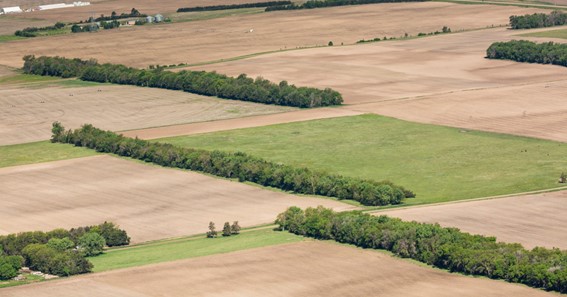Are you curious to know what is shelter belts? You have come to the right place as I am going to tell you everything about shelter belts in a very simple explanation. Without further discussion let’s begin to know what is shelter belts?
In an era of increasing environmental concerns and the need for sustainable land management practices, shelter belts have emerged as an effective and eco-friendly solution. These strategic plantings of trees and shrubs not only enhance the beauty of landscapes but also offer a range of environmental benefits. In this blog, we will explore the concept of shelter belts, their functions, and their positive impact on the environment and human well-being.
What Is Shelter Belts?
Shelter belts, also known as windbreaks or windrows, refer to rows of trees or shrubs planted in specific patterns to create barriers that shield against wind, reduce soil erosion, and provide various other ecological advantages. They are typically designed to protect crops, livestock, homes, and other structures from the detrimental effects of strong winds, while also promoting biodiversity and environmental sustainability.
Functions And Benefits Of Shelter Belts:
-
Wind Protection:
One of the primary functions of shelter belts is to act as windbreaks. By creating a physical barrier, they help mitigate the negative impacts of strong winds, such as wind erosion, crop damage, and soil loss. The trees and shrubs in shelter belts effectively reduce wind velocity, creating a sheltered microclimate that benefits both plants and animals.
-
Soil Conservation:
Shelter belts play a vital role in soil conservation by minimizing erosion. The trees and shrubs in these protective barriers intercept windblown soil particles, reducing the risk of soil erosion and improving soil quality. This helps maintain soil fertility, retain moisture, and prevent nutrient loss, benefiting agricultural productivity.
-
Biodiversity and Habitat Creation:
Shelter belts contribute to biodiversity conservation by providing habitats for a variety of flora and fauna. They offer nesting sites, food sources, and shelter for birds, insects, and small mammals. The diversity of plant species in shelter belts also supports pollinators, enhancing overall ecological balance and resilience.
-
Climate Regulation:
Shelter belts can contribute to climate regulation by acting as carbon sinks. The trees and shrubs absorb carbon dioxide from the atmosphere during photosynthesis, helping to mitigate the effects of greenhouse gas emissions and combat climate change. Additionally, shelter belts can moderate temperature extremes and reduce energy demands for heating and cooling in surrounding areas.
-
Aesthetics and Visual Appeal:
Shelter belts enhance the visual appeal of landscapes and add aesthetic value to both rural and urban areas. They provide natural beauty, break up monotonous landscapes, and create a sense of tranquility. The presence of green spaces has also been linked to improved mental well-being and quality of life for individuals living in proximity.
Implementation And Considerations:
When establishing shelter belts, certain factors should be taken into account:
- Site Selection: The location and orientation of shelter belts should be carefully considered to maximize their effectiveness. Factors such as prevailing wind directions, terrain, and the specific needs of the area (e.g., crop protection, soil erosion control) should guide the design and placement of the shelter belts.
- Plant Selection: The choice of tree and shrub species for shelter belts should consider the local climate, soil conditions, and specific objectives. Native species are often preferred for their adaptability, resilience, and ability to support local ecosystems.
- Maintenance: Regular maintenance, such as pruning, weeding, and replacement of damaged plants, is essential to ensure the long-term health and effectiveness of shelter belts. Adequate care will promote growth, density, and overall functionality.
Conclusion:
Shelter belts exemplify the harmony between humans and nature, offering a range of environmental benefits while serving practical purposes. By effectively reducing wind velocity, preventing soil erosion, supporting biodiversity, and enhancing visual appeal, these strategic plantings contribute to sustainable land management. As we embrace the importance of environmental stewardship, shelter belts stand as a testament to the power of nature-based solutions in creating resilient and harmonious ecosystems for the benefit of both present and future generations.
FAQ
What Is Shelter Belting?
WHAT IS A SHELTERBELT? Shelterbelts are linear plantings of multiple rows of trees or shrubs established for environmental purposes such as protecting farmsteads and livestock areas, saving energy, and to enhance wildlife habitat.
What Is The Difference Between A Wind Break And A Shelter Belt?
Windbreaks: consist of a line of defence such as a hedge, fence, single or double row of trees and can therefore be created in most gardens. Shelterbelts: are formed of tall trees and shrubs (over 4.5m/14½ft) planted in three or four staggered rows and are therefore only suitable for larger sites.
Why Are Shelter Belts Good?
The Benefits of Farmstead Shelterbelts
Home Energy Conservation – Well designed shelterbelts will often cut winter heating bills, by as much as 30%. Cost Savings in Livestock Production – By reducing wind chills, shelterbelts cut feed costs because livestock require less feed to maintain body weight.
What Is The Summary Of Shelterbelts?
A shelterbelt is a line of trees or shrubs planted to protect an area. Usually they protect farm fields from strong winds that cause erosion.
I Have Covered All The Following Queries And Topics In The Above Article
What Is Shelter Belts
What Is Shelter Belts Class 8
What Is Shelter Belts Class 10
What Is The Meaning Of Shelter Belts
What Is Planting Of Shelter Belts
What Is The Use Of Shelter Belts
What Is Shelter Belts
What do shelter belts represent
What is a shelter belt?
